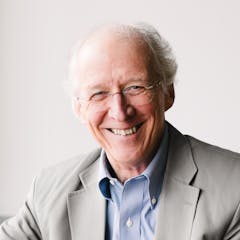Audio Transcript
Speaking of preaching, we have another question, this one from a podcast listener named Caleb who writes in to ask this: “Pastor John, the teaching style of Look at the Book is extremely helpful — as you mark up a Bible text on a screen. Would do you ever consider adopting this method for when you preach a sermon? Why or why not?”
I will probably lose this battle because of how omnipresent visual media are in our day. And I love to use them in their right place, but I suspect I will fight this battle until the day I die. No, I don’t encourage the use of any visual media in preaching, including what I do in Look at the Book. Look at the Book, for me, is an exposure for others to see what I do in private to get at the meaning of texts and to get ready to preach or teach. It is not a replacement for preaching. And I do think there is a place for it; namely, Look at the Book-type analysis of texts with an overhead projector or some kind of media. I do think there is a place for that in the church and I would encourage pastors and Sunday School teachers to do it in classes and other settings that are not considered the heralding of God’s Word, but rather the more informal explaining of texts.
In other words, I don’t think preaching is the only important form of communication in the New Testament or in the church. There is a place for visual analysis like Look at the Book and a place for discussion and a place for Q&A and a place for poetic expression and song, et cetera, et cetera. But none of these is preaching. And I want to preserve the integrity of preaching as preaching. I think it has a special place in God’s design and God’s purposes for the church.
Now before I say why that is, let me just make clear that in all my 40+ years of preaching, I have never in my own church used an overhead projector or a slide or a picture or a movie clip or a skit or anything else. I know that this is almost taken for granted nowadays by preachers and I don’t expect everybody to follow me in this regard, but it might have a leavening effect for good if I just at least give my opinion for why minimal or zero media in preaching is better.
It has to do with my understanding of the very nature of preaching.
When Paul says in 2 Timothy 4:2, “preach the word,” he uses a word, keruso, which implies heralding — like what a town crier does: “Hear ye, hear ye, hear ye, the emperor has a message for all the people of the empire. All who are involved in the recent insurrection will be granted full amnesty if they lay down their weapons and swear allegiance to the king!” That is what a kerux does. He heralds. He announces. He proclaims. Now he might have to circle back and explain for somebody on the front row what amnesty means, like, “Oh, excuse me, preacher? Amnesty? What are you talking about?” But he will never speak as one who is indifferent, and he knows he carries great news of utterly important things from an infinitely important king.
And so I have called preaching expository exultation. Preaching exults over the truth that it explains. And this exultation is a work of the Holy Spirit, or it is unreal. It is an act of Spirit-anointed worship. It is experience of the truth as glorious and beautiful and precious, even while the truth is being explained. And therefore, preaching is a work of the Holy Spirit. It carries in it a power: the old-fashioned word “unction,” an anointing from God for the accomplishment of his miraculous purposes in preaching.
My experience is that the intrusion of other media into this moment of Spirit-anointed heralding does two negative things. 1) It signifies a loss of trust in the preached word itself. And 2) it distracts from the actual spiritual dynamic of the flow of the power of the Spirit from the Word to the preacher to the people. It starts to create an atmosphere of the classroom or the lecture hall or the theater, and all of those atmospheres are contrary to what I call the atmosphere of expository exultation, the very atmosphere of worship. This preacher is worshiping over the Word and a sacred mediation of divine truth is happening in the minds and hearts of people. Preaching has its own dynamic and its own atmosphere. It is a kind of incarnation in the preacher of the beauty and the value of the truth of God’s word in Scripture.
So I say again, I doubt that I will win this battle, but it seems to me that preaching of this kind was not a temporary phenomenon for the first 2000 years of Christian history followed by something more technologically arresting for the remainder of church history. I suspect that for those who have really tasted the nature of true preaching, there will always be a pull away from technical media intrusions into that sacred, precious, powerful hour called expository exultation. If they know it, there is nothing like it.
Thank you. Yet I can imagine some listeners familiar with Bethlehem’s multi-campus model will ask how does this priority not conflict with preaching on video and using video of the preacher preaching, either live or recorded?
I have done it for many years at Bethlehem, because we have campuses. I regard it as not ideal. It seemed to be the best solution given our options, well, 13 years ago. That is a little different than what I was talking about in the sense that a video is an attempt to capture the moment of preaching, not intrude into the moment of preaching with something different from preaching. You see the difference.
I would much rather be encountering the people face-to-face because of the living dynamic between the preacher and the people, but all the arguments that I just gave are not mainly arguments against duplicating the authentic moment of preaching by showing it on a screen in another place or, even in the same place — like when I preach at Passion, they get a screen up there, because they can’t see me from a quarter of a mile away up in the bleachers.
So I don’t think anything I have said is undermined by the use of the replication of the moment in another place by the video. Nevertheless, I would say that in the fullest, most wonderful moment of expository exultation it is an incarnation of a real person and a real people connecting in a real room.




